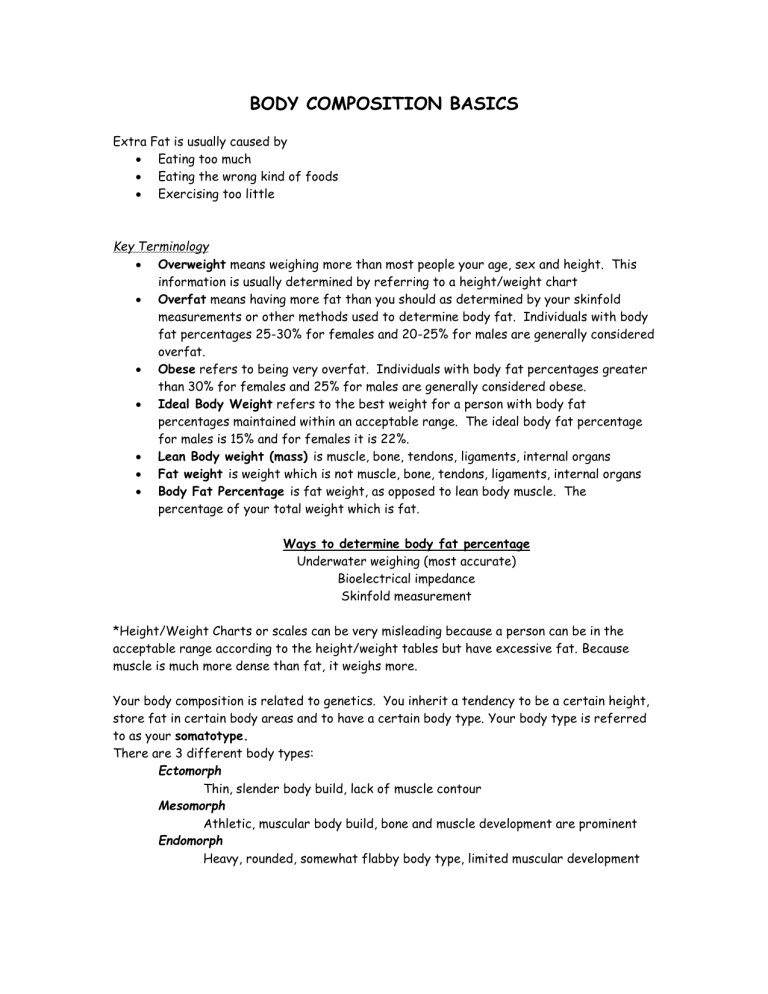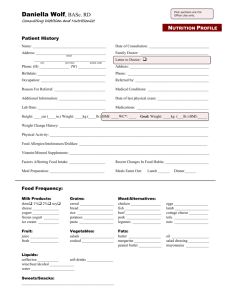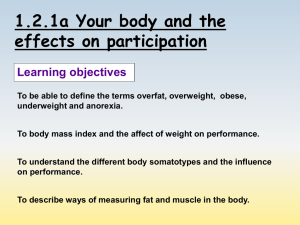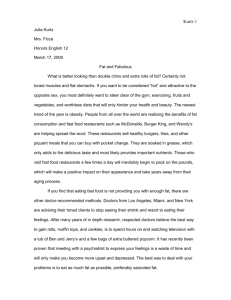Unit 3 Notes " Understanding Body Composition"

BODY COMPOSITION BASICS
Extra Fat is usually caused by
Eating too much
Eating the wrong kind of foods
Exercising too little
Key Terminology
Overweight means weighing more than most people your age, sex and height. This information is usually determined by referring to a height/weight chart
Overfat means having more fat than you should as determined by your skinfold measurements or other methods used to determine body fat. Individuals with body fat percentages 25-30% for females and 20-25% for males are generally considered overfat.
Obese refers to being very overfat. Individuals with body fat percentages greater than 30% for females and 25% for males are generally considered obese.
Ideal Body Weight refers to the best weight for a person with body fat percentages maintained within an acceptable range. The ideal body fat percentage for males is 15% and for females it is 22%.
Lean Body weight (mass) is muscle, bone, tendons, ligaments, internal organs
Fat weight is weight which is not muscle, bone, tendons, ligaments, internal organs
Body Fat Percentage is fat weight, as opposed to lean body muscle. The percentage of your total weight which is fat.
Ways to determine body fat percentage
Underwater weighing (most accurate)
Bioelectrical impedance
Skinfold measurement
*Height/Weight Charts or scales can be very misleading because a person can be in the acceptable range according to the height/weight tables but have excessive fat. Because muscle is much more dense than fat, it weighs more.
Your body composition is related to genetics. You inherit a tendency to be a certain height, store fat in certain body areas and to have a certain body type. Your body type is referred to as your somatotype.
There are 3 different body types:
Ectomorph
Thin, slender body build, lack of muscle contour
Mesomorph
Athletic, muscular body build, bone and muscle development are prominent
Endomorph
Heavy, rounded, somewhat flabby body type, limited muscular development
Body Mass Index (BMI)
BMI is a measurement of your body composition calculated by using height, weight, age and gender. BMI charts use percentiles to help people look at their BMI compared to a very large group of people with the same age and gender.
**BMI LAB**
In order to determine your BMI, go to the following web site www.kidshealth.org/teen/food_fitness/dieting/bmi.html
and input the required information
(height, weight, birthday and gender). Print off the BMI Calculator, turn in to your teacher for a lab grade and then place in your folder for future reference in class
Reasons to worry about Excess Fat o High blood pressure o Increased level of cholesterol and fats in the blood o Many types of bone and join disorders o Diabetes o Lower back difficulties o Respiratory ailments o Greater chance of accidents o
Surgical Risk
Causes of Overweight and Overfat
Heredity and Environment
Childhood Obesity (Human fat cells increase in number very rapidly during childhood)
Inactivity (the main reason/cause for high obesity)
High Fat Diet
Medical Problems
Creeping Obesity (the gradual weight gain during aging)
*The key to managing your weight is to balance your caloric intake (what you eat and drink) and expenditure (exercise). You must burn up calories you take in.
A pound of fat = 3500 Calories. If you want to lose weight, you should take in fewer calories per day or burn up more calories per day.
*The best strategy for a lifetime of successful weight control is a sound, nutritious diet combined with regular vigorous (aerobic) exercise.
Diet + Exercise = weight control.
Exercise and activity allow you to burn calories. Activities that are vigorous involve the entire body (aerobic type activities such as fast walking, running, swimming, Tae Bo) and if sustained over a period of time will burn the most calories. Exercise also improves the body’s ability to burn fat. As one loses fat through increased exercise, lean muscle tissue, muscle tone and firmness is increased. Weight lost through exercise tends to stay off!
UNHEALTHY WAYS TO LOSE WEIGHT
Fad Diets
Diet Aids
Fasting and Extreme Caloric restriction
Myths about Weight Control
Spot reducing – the idea one can lose fat in a particular area of the body by exercising the muscles in that area
Eliminating cellulite – there is really no such thing as cellulite. The fat dimples are caused by the way fat gets trapped between connective tissues that lay between your skin and other muscles
Special Equipment – electric stimulators, plastic or rubberized sweat suits, inflated belts, body wraps, etc. are totally ineffective and can be harmful.
Dangers of Dieting
Anorexia Nervosa – a condition of self-imposed starvation in order to maintain an extremely low body weight.
Bulimia – a pattern of binge eating and purging (eliminating) the food by vomiting and laxatives.
Ways to Gain Weight Safely
Use muscle building exercise
Substitute fruit juices and skim milk for beverages such as coffee and tea
Drink a commercial nutritional supplement
Eat healthy snack between meals
Eat three meals or more per day consistently. Do not skip a meal
Drink extra fluids
Don’t gain weight by eating more high-fat foods







